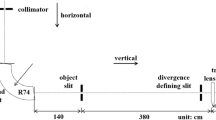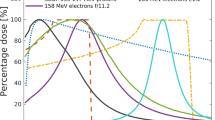Abstract
A “broadbeam” facility is demonstrated for the vertical microbeam at Surrey’s Ion Beam Centre, validating the new technique used by Barazzuol et al. (Radiat Res 177:651–662, 2012). Here, droplets with a diameter of about 4 mm of 15,000 mammalian cells in suspension were pipetted onto defined locations on a 42-mm-diameter cell dish with each droplet individually irradiated in “broadbeam” mode with 2 MeV protons and 4 MeV alpha particles and assayed for clonogenicity. This method enables multiple experimental data points to be rapidly collected from the same cell dish. Initially, the Surrey vertical beamline was designed for the targeted irradiation of single cells with single counted ions. Here, the benefits of both targeted single-cell and broadbeam irradiations being available at the same facility are discussed: in particular, high-throughput cell irradiation experiments can be conducted on the same system as time-intensive focused-beam experiments with the added benefits of fluorescent microscopy, cell recognition and time-lapse capabilities. The limitations of the system based on a 2 MV tandem accelerator are also discussed, including the uncertainties associated with particle Poisson counting statistics, spread of linear energy transfer in the nucleus and a timed dose delivery. These uncertainties are calculated with Monte Carlo methods. An analysis of how this uncertainty affects relative biological effect measurements is made and discussed.





Similar content being viewed by others
References
Auer S, Hable V, Greubel C, Drexler GA, Schmid TE, Belka C, Dollinger G, Friedl AA (2011) Survival of tumor cells after proton irradiation with ultra-high dose rates. Radiat Oncol 6:139
Barazzuol L, Jena R, Burnet N, Jeynes JCG, Merchant M, Kirkby KJ, Kirkby N (2012) In vitro evaluation of combined temozolomide and radiation using X-rays and high linear energy transfer radiation for glioblastoma. Radiat Res 177:651–662
Barber PR, Vojnovic B, Kelly J, Mayes CR, Boulton P, Woodcock M, Joiner MC (2001) Automated counting of mammalian cell colonies. Phys Med Biol 46:63–76
Barber P, Locke R, Pierce G, Rothkamm K, Vojnovic B (2007) γ-H2AX foci counting: image processing and control software for high content screening. Proc SPIE 6441:64411 M-3
Beaton LA, Burn TA, Stocki TJ, Chauhan V, Wilkins RC (2011) Development and characterization of an in vitro alpha radiation exposure system. Phys Med Biol 56:3645–3658
Belli M, Cherubini R, Finotto S, Moshini G, Sapora O, Simone G, Tabocchini MA (1989) RBE-LET relationship for the survival of V79 cells irradiated with low-energy protons. Int J Radiat Biol 55:93–104
Besserer J, de Boer J, Dellert M, Gahn C, Moosburger M, Pemler P, Quicken P, Distel L, Schüβler H (1999) An irradiation facility with a vertical beam for radiobiological studies. Nucl Instrum Methods Phys B 430:154–160
Bettega D, Calzolari P, Doglia SM, Dulio B, Tallone L, Villa AM (1998) Cell thickness measurements by confocal fluorescence microscopy on C3H10T1/2 and V79 cells. Int J Radiat Biol 74:397–403
Combs SE, Bohl J, Elsasser T, Weber KJ, Schulz-Ertner D, Debus J, Weyrather WK (2009) Radiobiological evaluation and correlation with the local effect model (LEM) of carbon ion radiation therapy and temozolomide in glioblastoma cell lines. Int J Radiat Biol 85:26–137
Durante M, Friedl AA (2011) New challenges in radiobiological research with microbeams. Radiat Environ Biophys 50:335–358
Folkard M, Prise KM, Vojnovic B, Davies S, Roper MJ, Michael BD (1989) The irradiation of V79 mammalian-cells by protons with energies below 2 Mev.1. Experimental arrangement and measurements of cell-survival. Int J Radiat Biol 56:221–237
Folkard M, Prise KM, Vojnovic B, Newman HC, Roper MJ, Michael BD (1996) Inactivation of V79 cells by low-energy protons, deuterons and helium-3 ions. Int J Radiat Biol 69:729–738
Folkard M, Vojnovic B, Prise KM, Bowey AG, Locke RJ, Schettino G, Michael BD (1997) A charged-particle microbeam. 1. Development of an experimental system for targeting cells individually with counted particles. Int J Radiat Biol 72:375–385
Frese MC, Wilkens JJ, Huber PE, Jensen AD, Oelfke U, Taheri-Kadkhoda Z (2011) Application of constant vs. variable relative biological effectiveness in treatment planning of intensity-modulated proton therapy. Int J Radiat Oncol Biol Phys 79:80–88
Friedrich T, Scholz U, Elsässer T, Durante M, Scholz M (2013) Systematic analysis of RBE and related quantities using a database of cell survival experiments with ion beam irradiation. J Radiat Res 54:494–514
Goodhead DT, Bance DA, Stretch A, Wilkinson RE (1991) A versatile plutonium-238 irradiator for radiobiological studies with alpha particles. Int J Radiat Biol 59:195–210
Konsihi T, Yasuda N, Takeyasu A, Ishizawa S, Fujisaki T, Matsumoto K, Furusawa Y, Sato Y, Hieda K (2005) Irradiation system of ions (H-Xe) for biological studies near the Bragg peak. Rev Sci Instrum 76:114302–114307
Levy RP, Blakely EA, Chu WT, Coutrakon GB, Hug EB, Kraft G, Tsujii H (2009) The current status and future directions of heavy charged particle therapy in medicine. Appl Accel Res Ind 1099:410–425
Merchant MJ, Palitsin V, Grime GW (2009) The use of the Wien filter to eliminate object slit scattering in MeV ion nanobeam systems. Nucl Instrum Methods Phys B 267:2021–2023
Merchant MJ, Jeynes JCG, Grime GW, Palitsin V, Tullis IDW, Barber PR, Vojnovic B, Kirkby KJ (2012) A focused scanning vertical nanobeam for charged particle irradiation of living cells with single counted particles. Radiat Res 178:182–190
Miller RC, Randers-Pehrson G, Geard CR, Hall EJ, Brenner DJ (1999) The oncogenic transforming potential of the passage of a single alpha particle through mammalian cell nuclei. Proc Natl Acad Sci USA 96:19–22
Mortel H, Georgi J, Eyrich W, Fritsch M, Distel L (2002) Automation of the particle dosimetry and the dose application for radiobiological experiments at a vertical proton beam. Nucl Instrum Methods Phys A 489:503–508
Schettino G, Folkard M, Prise KM, Vojnovic B, Bowey AG, Michael BD (2001) Low-dose hypersensitivity in Chinese hamster V79 cells targeted with counted protons using a charged-particle microbeam. Radiat Res 156:526–534
Schmid TE, Dollinger G, Hauptner A, Hable V, Greubel C, Auer S, Friedl AA, Molls M, Röper B (2009) No evidence for a different RBE between pulsed and continuous 20 MeV protons. Radiat Res 172:567–574
Schuff JA, Policastro L, Duran H, Kreiner AJ, Mazal A, Molinari BL, Burlon A, Debray ME, Kesque JM, Somacal H et al (2002) Relative biological effectiveness measurements of low energy proton and lithium beams on tumor cells. Nucl Instrum Methods Phys B 187:345–353
Simon A, Jeynes C, Webb RP, Finnis R, Tabatabian Z, Sellin PJ, Breese MBH, Fellows DF, van den Broek R, Gwilliam RM (2004) The new Surrey ion beam analysis facility. Nucl Instrum Methods Phys B 219:405–409
Ziegler JF (2004) SRIM-2003. Nucl Instrum Methods Phys B 219:1027–1036
Acknowledgments
The authors would like to thank the Wolfson Foundation, the UK Engineering and Physical Sciences Research Council (EPSRC) and the EU Framework 7 programme and Marie Curie Action for their support of this project. This work was funded under EPSRC projects Laser Induced Beams of Radiation and their Applications [LIBRA (EP/E035728/1) and CONFORM (EP/E01397X/1)]. Some of the work was also conducted under EU FP7 Infrastructure project SPIRIT, while the work of Barazzuol was conducted under Marie Curie Initial Training Network PARTNER. The authors also acknowledge the invaluable work of M. Browton during beamline construction and C. Jeynes for valuable discussions on this manuscript. The authors also thank the Royal Surrey County Hospital (Guildford, UK) for the use of the Pantak X-ray irradiation system used for the X-ray experiments described in this paper.
Author information
Authors and Affiliations
Corresponding author
Rights and permissions
About this article
Cite this article
Jeynes, J.C.G., Merchant, M.J., Barazzuol, L. et al. “Broadbeam” irradiation of mammalian cells using a vertical microbeam facility. Radiat Environ Biophys 52, 513–521 (2013). https://doi.org/10.1007/s00411-013-0487-4
Received:
Accepted:
Published:
Issue Date:
DOI: https://doi.org/10.1007/s00411-013-0487-4




